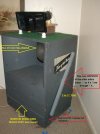Hope you are thoroughly confused by now

Well, I can try to get you out of here. Let's see!
(a)
"amps don't push power" -- 100% correct! In fact, this is the best way to understand an amplifier. It may seem counter-intuitive to begin with, but as you stay on, this will begin making sense.
(b)
"speakers are reactive loads" -- If an amplifier is asked to play one particular frequency at one particular SPL in to one specific transducer (speaker), it will behave like an ideal amplifier. Unfortunately, real world applications are different. A typical loudspeaker system is not just one transducer playing one note at one SPL. It's a combination of multiple transducers (each with usually varying electrical characteristics) and electronic circuit to coordinate among them (basically frequency/power division). Hence, a typical loudspeaker system is a complex electrical circuit with a not so straight forward characteristic. When they are delivered power or when they draw power their characteristics changes with frequency, amplitude etc. Hence, they are not just a simple load (like a resistor) but a reactive load.
(c) About
turning the knob -- let me try with a simple analogy.
Think of an amplifier as a water tank. This water tank (the amplifier) has a reserve of electrical power. This tank is connected to another tank where the water (electrical charge) is to be delivered (the speakers). A speaker usage that electrical charge to produce sound. So, technically, a loudspeaker is an electrical to acoustic energy converter. Like with any energy conversion device there are some conversion losses, in a loudspeaker, too. But that's not the main point. Main point is - this loudspeaker represents our target tank where the power is to be delivered/drawn (with the source tank being the amplifier).
Now these two tanks need to be connected via a pipe in order for the electrical charge to flow. This pipe is what we call the speaker cable. Here is it easy to see the importance of speaker cables. In our example: for a smooth flow of electric charge from the source tank (the amp) to the target tank (the loudspeakers) the pipe needs to (
1) be thick enough to be able to keep up with the charge requirement in the target tank, and (
2) not have any internal friction, causing disruption to the flow. This applies exactly the same way for speaker cable. An ideal speaker cable should be thick enough keeping in mind the current requirements, and should have near zero resistance of its own.
Now that we have got one more step closer, lets take a look at the final piece. The
volume control -- well, what would happen if the two tanks were connected with a pipe? The flow will take place from a high potential to a low potential, to the maximum extent allowed by the connecting pipe. That is to say - all power available at the amplifier's taps will start getting dumped at the speakers binding terminal. That is the speakers will begin running at full power generated by/available at the amp. The result will likely be a blown loudspeaker, unless the amp has too little gain.
How do we prevent that? By installing a toti! Isn't it?
The volume control is also called a "
tap" for the same reason. The volume control is also called a "
pot" for the reason that electrically this is achieved by installing (in simplest implementation) a potentiometer. The term potentiometer is abbreviated as "pot" in verbal communication. Now what can this pot do? Limit the flow, prevent the flow from happening at full rate all the time.
A potentiometer is a very simple electrical device. It's a continuously variable voltage divider. Just as a tap in our household control water flow, preventing it from flowing at full rate, a volume control prevent the loudspeaker from getting all the available charge at full rate. So a volume control is a limiting device. It is used to narrow the width of the pipe connecting the target tank with the source tank.
Just to build upon the point 2 above about reactive load -- Let's assume that the target tank is empty. In this case, the water flowing from source tank will not face any resistance upon arrival in the target tank. Now fill the target tank with some water. Now the water arriving from the source tank will face some resistance. Now fill some more water in the target tank. Now the water arriving at the target tank will face more resistance.
An even simpler way to understand is - open the tap in the kitchen and try to block it by tapping it with the palm. When you block the flow with palm, it is transferred as a change in the pressure in the tank.
This is precisely what happens in case of a real world loudspeaker system. Since it's a combination of various transducers and a crossover, it's impedance changes with frequency and amplitude. Hence a loudspeaker system is a reactive (in addition to a being a resistive) load.
Hope my effort towards explaining this made sense.


